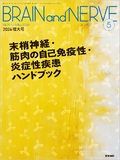Japanese
English
- 有料閲覧
- Abstract 文献概要
- 1ページ目 Look Inside
- 参考文献 Reference
自己免疫性ノドパチー(autoimmune nodopathy)はランヴィエ絞輪部および傍絞輪部に局在する膜蛋白(neurofascin 186,neurofascin 155,contactin-1,contactin-associated protein 1)に対する自己抗体が陽性となる免疫介在性ニューロパチーである。同疾患は免疫グロブリン療法の効果が乏しくリツキシマブが奏効するため,関連する自己抗体を測定することは,診断のみならず治療方針を決定するうえで重要な役割を果たす。
Abstract
Autoimmune nodopathy (AN), a newly established category of autoimmune disease, refers to an immune-mediated neuropathy associated with development of autoantibodies against membrane proteins, including neurofascin 186, neurofascin 155, contactin-1, and contactin-associated protein 1 located in the nodes of Ranvier or paranodes. Subclass analysis of these autoantibodies reveals predominant elevation of immunoglobulin (G4. Patients with AN show clinical and laboratory characteristics such as distal-predominant sensorimotor disturbance, sensory ataxia, poor response to intravenous immunoglobulin, and highly elevated cerebrospinal fluid protein levels. B cell-depletion therapy using an anti-CD20 monoclonal antibody is effective for patients with AN. Autoantibody measurement is beneficial not only for diagnosis but also for deciding treatment strategies for AN.

Copyright © 2024, Igaku-Shoin Ltd. All rights reserved.


